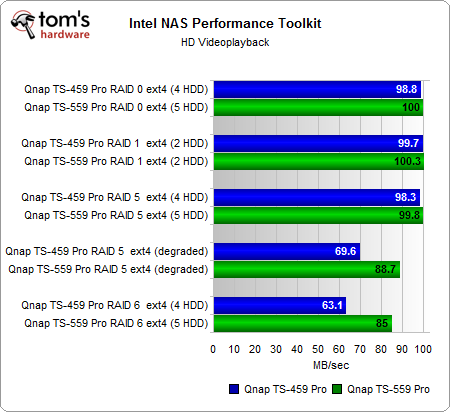Qnap TS-559 Pro: Do More Drives In Your NAS Mean More Speed?
We know that adding drives to a RAID array can help improve performance. But does adding storage to a NAS device really help push throughput higher? We put four-bay and five-bay units from Qnap up against each other and benchmark their transfer rates.
Benchmark Results: Multimedia
We have summarized the results and organized them by RAID mode for better overview. The four-drive bay Qnap TS-459 Pro is represented by the blue bars in the charts below, while the five-drive bay TS-559 Pro is represented by the green bars.
The HD video recording test consists of 100% sequential data writes, and only really shows a difference in data transfer rates in the RAID 5 mode. In RAID 0 they are quite similar due to the gigabit network port posing a bottleneck. We attribute the marginal differences in test results to measurement margins of error. A similar picture emerges in the RAID 1 mode, with the 2.6 MB/s difference being rather low. The gaps between RAID 5 and 6, at 7.1 MB/s and 8 MB/s, are a bit larger.
The sequential read operations in the HD video playback tests are quite similar. In RAID modes 0, 1, and 5, both NAS devices are at pretty much the same level of performance. The fifth hard drive in the TS-559 Pro becomes valuable in the RAID 5 degraded mode and RAID 6 modes, where the performance benefit speaks in favor of the five-bay version.
There are hardly any noticeable differences in performance between the NAS devices when working with huge amounts of very small files (photo album, four bytes to 102 KB) either. The difference in the RAID 6 mode is lower than when reading or writing sequential data. Only in the degraded version of the RAID 5 mode is the TS-559 Pro able to achieve any higher transfer rates.
More benchmark results can be found in the gallery.
Get Tom's Hardware's best news and in-depth reviews, straight to your inbox.
Current page: Benchmark Results: Multimedia
Prev Page Test System, Details, Power Consumption Next Page Benchmark Results: Backup And Office-
thomaseron "We put four-bay and five-bad units..."Reply
Haha! ;-)
EDIT: They have corrected it now... :-) -
Zoidman I set a TS-459 up at my work, and that machine is a piece of beauty! It runs a copy of linux on it which is root accessible by SSH thus unlocking all the potentials you could ever want! It adds a huge amount of value to the devices in my opinion and would recommend it to a business looking for a basic backup system.Reply -
ProDigit10 Who would want to pay that for a nas server?Reply
Just purchase a micro atx board + case + Atom N550/D525 and 2GB of ram, and install 2 or 4 harddrives in RAID.
It'll cost you less than $400!
5 drives and up is indeed harder to get, but definitely NOT worth trice the price!
Besides, the Atom is a very small CPU which would bottleneck when 2 or 3 drives are copy/moving data. I don't think it's even wise from performance standpoint of view to buy any Atom NAS server with more than 3 or 4 drives!
comment made before reading article. -
Agges Supporting ProDigit10's sentiment..Reply
How about adding a 'building your own NAS/server' guide, including testing the sweet-spot for price/performance for various set-ups..? -
mjw It looks like the network may be a bottleneck in a number of your tests. It would be interesting to see if the performance increases when the dual gigabit NICs are run in teaming mode.Reply -
KentC I bought an Acer Home Server with 4 hot swap drive bays and one drive bay with a 1tb drive with the server OS for $350. It looks like these units provide less and cost almost three times as much. Why are they so expensive? What does 3x the cost buy me?Reply -
joex444 I'm with mjw here. If the highest number you ever achieved is 116MB/s you're limited by GbE rather than anything else. When a 2 drive RAID1 performs the same as a 5 drive RAID5 you have some other problem.Reply
I run an external 8 bay unit, all drives filled with 2x250GB drives for OS and 6x750GB drives for RAID5. The biggest problem I have in terms of getting an idea of the true transfer rates capable is the fact that the RAID5 can write faster than the other array reads. And copying from an array to itself always has issues. So in real-world apps, my write speeds are limited by the read speed of other devices. The only logical way to untangle the two is to run a separate 6 drive RAID5 array, but I'm out of PCIe 8x slots to do so (as well as money). -
mikem_90 Part of what you pay for is the software development for all the features they give out of the box. Sure you could build your own, but it might not be as compact while offering hot swap and have an well designed interface with the well integrated features.Reply
These systems offer some very nice features I don't mind paying for.
Keep in mind that this is the corporate version, it has a much beefier CPU than the cheaper ones that cost a few hundred dollars less. They don't offer the same performance, but not everyone needs to use volume based encryption and send the files back and forth over SSL encrypted links.



